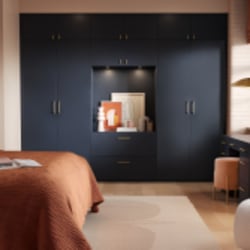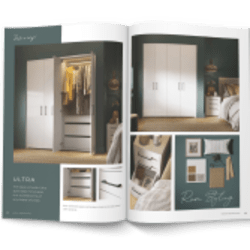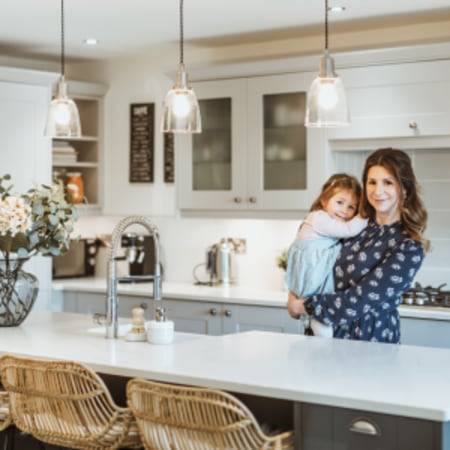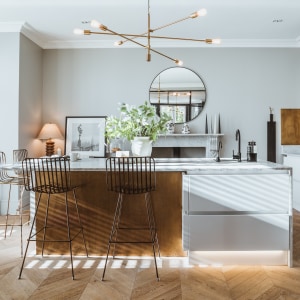Kitchen Flooring: Buying Guide
Kitchen Flooring
Each element involved in kitchen design is important, but your flooring is perhaps the most difficult feature to change. So it’s crucial to take the time to decide on the style that most-effectively suits your design scheme.
But with such a broad array of colours and materials to choose from, it’s easy to spend an eternity deliberating between different types of flooring. Fortunately, to offer handy inspiration and an experienced helping hand, we’ve created a guide that outlines all you’ll need to know about picking the right flooring for your kitchen.
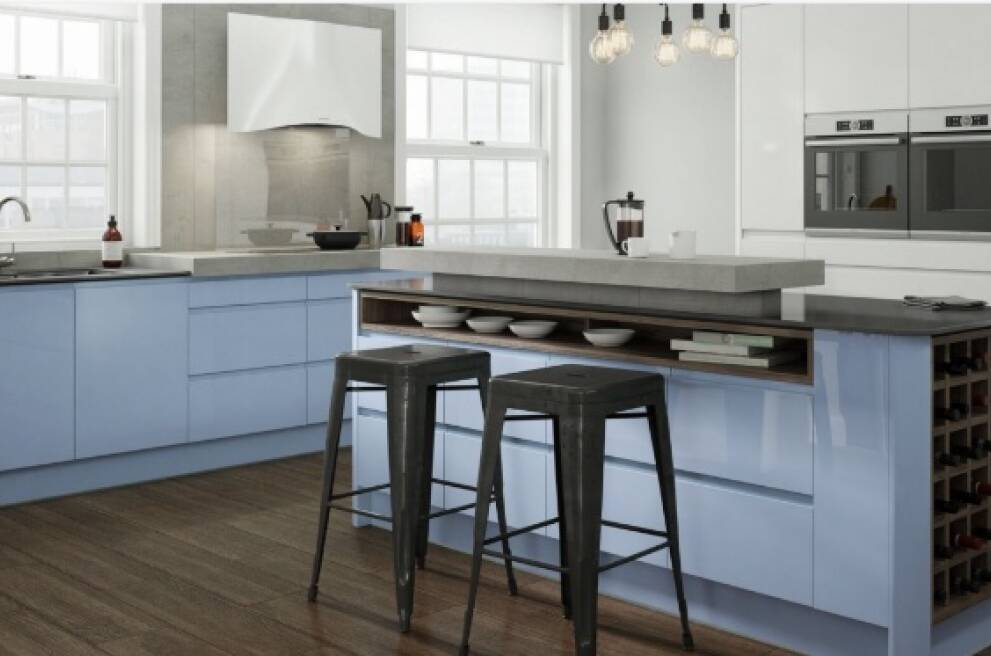
Before you start
Your flooring will stay down for quite some time, so it’s crucial that you fall in love with a gorgeous style and material. But before you can look at different designs and types of flooring, it’s important to measure your available space, analyse your budget, and consider your lifestyle.
Space
Before you’re able to buy flooring online or at a showroom, you’ll need to accurately measure the square meterage of your space. This will give you a clear indication of how much you’ll need to purchase.
To achieve this, in a standard square-shape room, measure from one wall to the opposite. Then repeat for the other two walls. You should then multiply these two figures, to reveal the overall size of your floor in square metres (if flooring is sold in square feet, simply measure in feet).
If your kitchen is an irregular shape, however, or you have an island or work surfaces jutting into the centre of your room, you may need to measure sections separately and combine for an accurate final figure. If you prefer, at Wren, we offer a straightforward home measurement service that handles the hassle and ensures you achieve a perfect flooring fit.
Budget
It’s important to recognise that not all types of kitchen flooring cost the same; some are considered an exclusive luxury, while some are affordable alternatives . In fact, even each type of material has a sliding spectrum of cost. With this in mind, budget is often one of the largest contributing influences when choosing between different types of flooring, with the material you choose likely down to what you can realistically afford.
This directly ties into the measurements of your kitchen floor, as a smaller kitchen will perhaps accommodate a higher-value material where the accumulative square metre cost won’t dent your finances too much. On the flip side, fitting expensive flooring in a larger space can quickly add up. To get the very best value out of your flooring, take the time to research available products, from authentic oak to sheet vinyl and laminate.
Vinyl and laminate are sold at the cheapest end of the scale, as they’re made of more available materials that mimic the look and texture of wood and stone, while sourcing the real deal can set you back over £20 per square metre.
Lifestyle
Inevitably, some flooring types are more durable than others, with some materials requiring regular maintenance and some just a quick once-over every now and then. When browsing the different types of flooring available, it’s important to think about your lifestyle, who lives in your home, and how much wear and tear you expect in the kitchen.
For example, if you live by yourself or just with a partner, you can probably expect to keep your floor in a reasonably condition between you. You might spill something or create the occasional mess, but you know how to take care. As such, you might want to spend a little more on luxury flooring. However, if you’re renovating your kitchen in the family home, with excitable children and messy pets wreaking havoc, you’ll probably favour a more affordable and low-maintenance solution.
Kitchen flooring materials
There are various kitchen flooring types available to choose from, so it’s important to know the benefits and drawbacks of each. We’ve explored all you’ll need to know about laminate, vinyl, and wood.
Vinyl kitchen flooring
Typically, the most affordable of all types of flooring, vinyl is a practical solution to busy kitchens that see a lot of action and heavy footfall. Made entirely from layered synthetic materials (typically fibreglass, PVC, and plasticiser), vinyl kitchen flooring is incredibly durable and resilient, making it the ideal choice where wear and tear is the norm; it can handle everything from frantic children to heavy socialising, and everything in between. And what’s more, because it’s fashioned from layered materials, it can also absorb the impact of clumsily dropped kitchenware with relative ease, so you’re unlikely to suffer from shattered glass or shards of plate.
Vinyl is available in a range of styles and colours, making it an affordable alternative to more luxury materials, such as solid oak or stone tiles. This strengthens its case as one of the most popular picks for larger kitchens, where a high cost per square metre can quickly drain your budget.
As far as cleaning care is concerned, vinyl is among the easiest types of flooring to look after. It’s difficult to damage, so don’t worry about soaking the floor with a wet mop to clean up after untidy children and muddy pets, and small stains will simply wipe away. However, while maintenance is straightforward, installation can be tricky. Vinyl is fitted using a click-and-lock technique, where each piece is scored to size and positioned along the groove of the next. To guarantee a straight slice and neat alignment, professional help is generally advised.
Laminate kitchen flooring
Laminate flooring is similar to vinyl, in that it’s available in a wide array of styles and colours that mimic almost any authentic material you can imagine. This includes a selection of faux floorboard patterns, multiple styles of stone, and realistic ceramic and tile imitations
The key difference between the two is that, while vinyl is made from layers of processed materials, laminate is made from wood by-products and bound by resin. This means laminate is usually slightly thicker than vinyl. Because it has this extra depth, laminate flooring can be made to look more realistic, which can be a bonus if you’re looking for a textured material alternative. For instance, thick oak boards are rich and rugged, and this can be replicated with three-dimensional laminate embossing.
Unlike vinyl flooring, however, laminate doesn’t respond well to water damage; usually, if there’s a severe spillage or small pool (perhaps from a flooded dishwasher), you’ll need to replace the entire affected area of laminate, whereas vinyl can be dried out and reused time and time again. However, in terms of standard lifespan, if there’s no damage incurred, both vinyl and laminate should comfortably last for 20 years before showing signs of aging.
Solid and engineered wood flooring
When comparing different types of flooring materials, laminate and vinyl have their benefits, but wood still remains a strong favourite. Once you’ve decided that you’re going for an authentic wooden finish, the next decision you’ll be faced with is whether to choose solid or engineered. As you might imagine, solid wood comes as a single piece of hardwood, while engineered wood is made of multiple layers.
The benefits of choosing solid wood for your kitchen flooring is its traditional charm and luxurious finish, ideally placed to complement a classically styled space centred around natural colours and organic materials. Additionally, as solid wood is a single piece of timber, with a long lifespan, it can be sanded and re-finished over and over, as and when kitchen wear and tear starts to show. From a practical standpoint, however, solid wood can be difficult to install for first-timers, even if the tongue and groove fitting system is fairly intuitive once you get the hang of it.
Engineered wood, on the other hand, is generally considered to be easier to install, with most planks fit according to a ‘click system’. Other advantages of engineered wood include its cost-effectiveness, especially considering it has an almost indistinguishable resemblance to the real thing once laid down (it has a layer of hardwood on top), and its versatility in instances of changing temperature and humidity. Additionally, if you’re hoping to employ underfloor heating in your new kitchen, it’s worth noting that only engineered of the two supports this.

Kitchen flooring colours
Colour choices are entirely subjective, especially in the home and kitchen where you might use vibrant tones to express your character and personal taste. However, there’s no denying that some shades are more popular than others – especially when it comes to flooring! If you’re after a little inspiration, check out some of the best colour combinations used across traditional, contemporary, and shaker kitchens.
Modern kitchen flooring colours
Modern kitchens are generally styled around minimalism, clean lines, and smooth surfaces. So, a monochromatic colour scheme is popular when complementing a contemporary theme. Think two-tone black and white checkerboard tiles, beautifully marbled stone, or dark laminate as a base colour for your modern space.
Alternatively, think about how you can use your flooring to inject a splash of personality into your space. This can come through light pastel tones, offering contrast against a crisp white wall, or bold and popping hues that show off your colourful side.
Traditional kitchen flooring colours
Traditional kitchens are typically centred around natural materials, such as wood, stone, ceramics, and even metallics, so it’s important to choose colours that complement this theme. The obvious picks are earthy browns and stony creams, but you might want to experiment a little and offer a bit more excitement. After all, the kitchen is the heart of the home, and somewhere you’ll be spending a lot of your time!
For something more adventurous in your classically-styled kitchen, consider timeless blues and greys, terracotta reds and pinks, and golden yellows, offering crisp contrast against clean white walls and cabinets.
Shaker kitchen flooring colours
Designed around efficiency, simplicity, and practicality, while never compromising on sleek style, shaker kitchens demand robust and minimalist flooring. However, you’re pretty much free to choose any type of material you like, so long as it’s functional and hardwearing. This means wood and stone are both on the table.
Whatever material you choose, though, it’s important to think about how your flooring will look alongside your cabinets and walls. Your kitchen is unlikely to follow a loud and bold theme, so your floor should follow suit. Think creams and whites, pale green, blues, and pinks, to offer subtle statement in your shaker-style space.
Where to buy kitchen flooring
Your new kitchen is unique to you, so it’s important that you’re able to choose the exact materials, colours, and features you want – including your flooring. For flexibility and ease, we offer two options when designing and buying your new kitchen: online or in person.
How to buy flooring online
At Wren, we appreciate that you might not want to visit one of our showrooms, especially when everything else is available at the touch of a button. So, you’re able to browse, design, and pay for your new kitchen directly through our online planning portal. This allows you to pick each individual feature you like, according to your own style and taste, including floor material and colour.
Visiting a showroom to browse flooring types
If you prefer to experience a product in person before purchasing, feel free to visit one of our many showrooms located across the UK. It’s worth noting that we only take visits by appointment, though. Upon arrival, you’ll be met by one of our expert designers who’ll turn your vision of perfection into a reality, getting to know your style and ideal design scheme. Just like with our online planner, you’ll be able to choose the exact specifications you want for your kitchen and floor.
Have you decided on your favoured style and ready to chat to one of our designers? Get in touch or book an appointment to visit your local showroom and turn your dream kitchen into a reality.








